Arts & Entertainment Community
Gig Harbor Now and Then | Tree rings reveal many mysteries
Recognizing that historical information can sometimes be found in unlikely places, our last Gig Harbor Now and Then question of local history was a rather broad one that asked:
Arts & Entertainment Sponsor
Arts & Entertainment stories are made possible in part by the Gig Harbor Film Festival, a proud sponsor of Gig Harbor Now.
What can the inside of trees tell us about local history?
Answer: Lots.
This week we’ll look at some of that history inside of trees. Specifically, the growth rings. We’ll break that down into more detail by taking a very close look at a specific tree.
Anatomy of a tree’s life
Except for being completely different, reading tree rings is exactly like palm reading, as long as the tree is a — nope, can’t do it. Can’t take the stupid joke. This time, anyway. There will be other opportunities.
Tree rings tell a lot about not only the life of the tree, but also some of the events that occurred on the land it grew on.
The terrific example we’ll use today shows some chainsaw marks, but is pretty smooth for a chainsaw cut. (Deliberately so; I wanted to read the rings.)
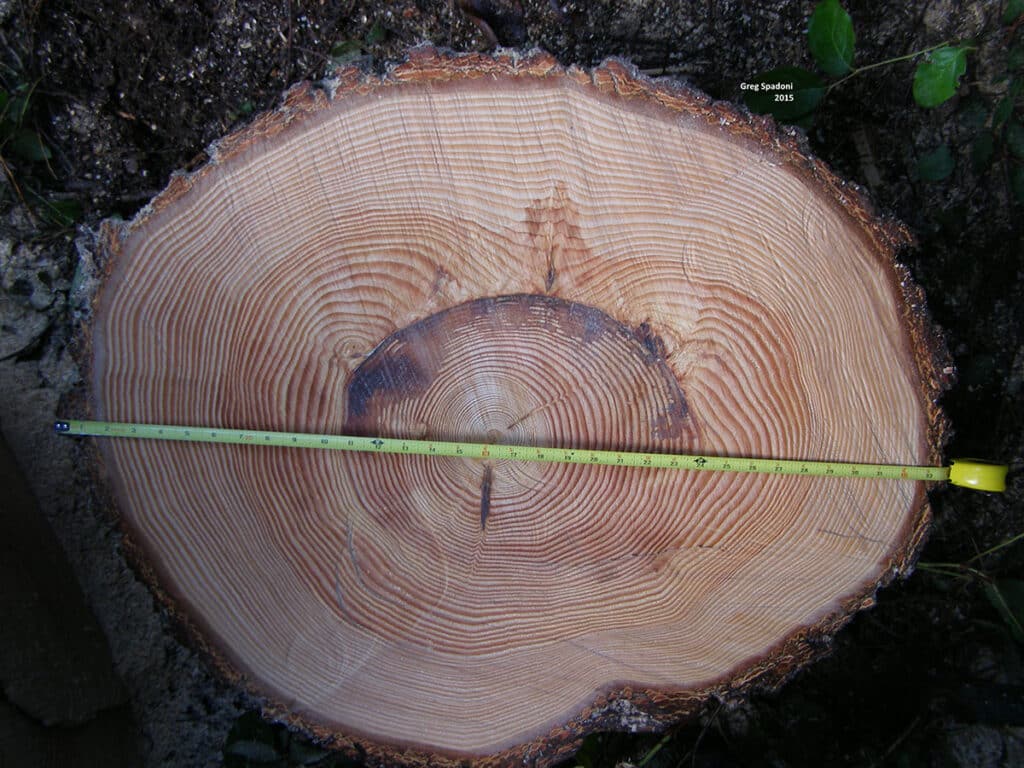
The tree in our example was 31 inches in diameter on the long axis, minus the bark. Photo by Greg Spadoni.
This cross section has five key points.
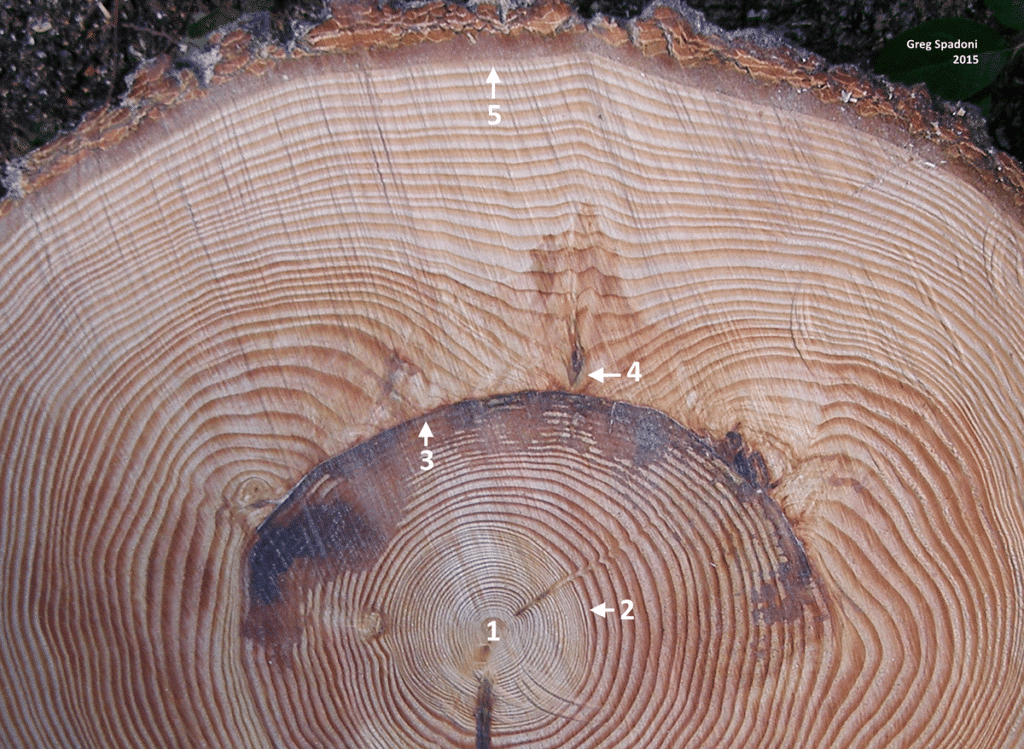
The growth rings on this Douglas fir stump show five significant events in the tree’s life. Photo by Greg Spadoni.
- The center, which is also the oldest ring on this cross section. The stump was cut about 24 inches above the ground, so we have to add a few years of growth from the seedling stage to the height of where it was cut down, which is always guesswork. We don’t know what the weather conditions were in those years, and we don’t know how much shade the seedling was under, both of which are critical factors.
- The first ring of faster growth.
- The point at which this tree suffered a major wound to the bark.
- The completion of the healing of the wound.
- The last ring added before the tree was cut down.
For this particular specimen, we know the exact year of numbers 3 and 5. That makes placing dates on the other three points much, much easier.
Injured on the job
The tree was wounded in September 1976. It took an accidental hit from a log being pushed by a bulldozer while clearing for a house. (Gee, who could that have been, on a Spadoni Brothers Caterpillar D-6?)
Quite a big chunk of bark was knocked off, maybe 40% of the way around the trunk, and about two and a half feet tall. As Douglas firs do, the tree immediately began to flood the wound with pitch. That seals off the exposed wood from insects and fungus. The darkness along the wound site is wood completely soaked with pitch. This tree successfully sealed itself off from potentially fatal invaders and continued to grow and thrive.
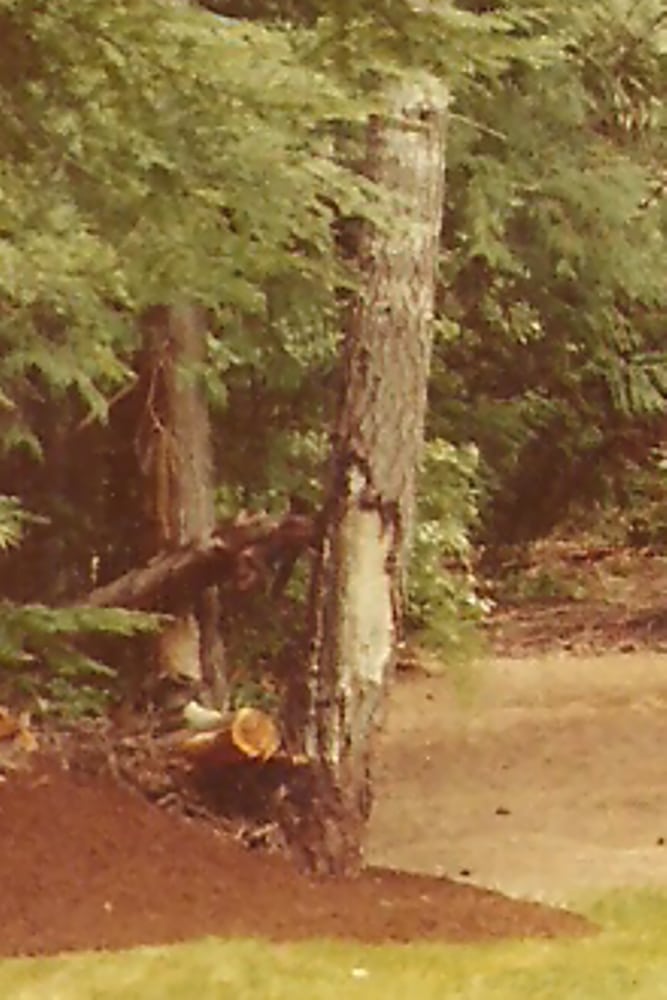
The bark wound on the Douglas fir was a large one. In this picture, taken five years later, the exposed sapwood had long since been completely covered by pitch, protecting the tree from insects and fungus. Photo by Greg Spadoni.
After successfully sealing off the wound, we can see how each year’s new growth made a small amount of progress in covering the pitch-sealed wound with new wood.
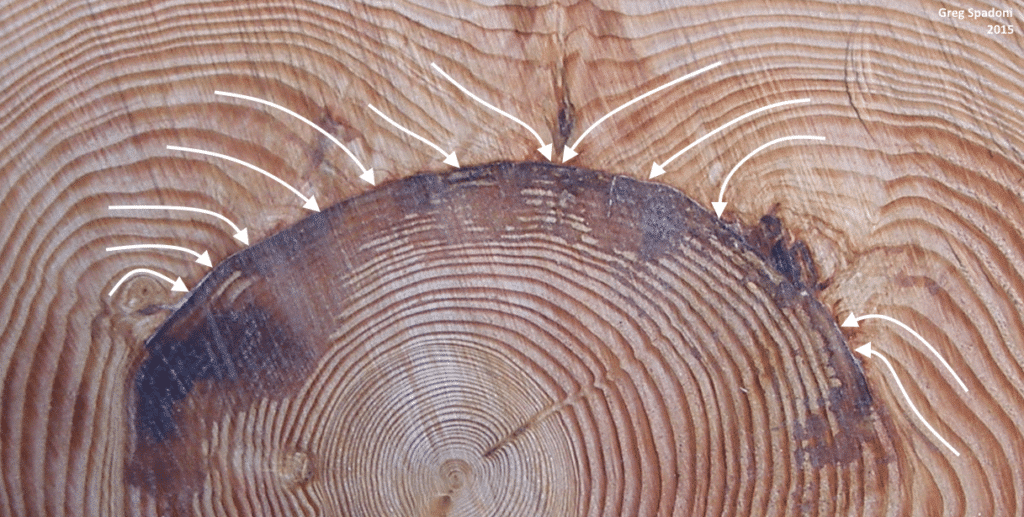
Year by year, new wood covered more of the wound site until it was completely healed over. Photo by Greg Spadoni.
It took 19 years for the tree to completely heal over the wound with new wood. It was in 1995 when the new sapwood reaching from both sides met at last.
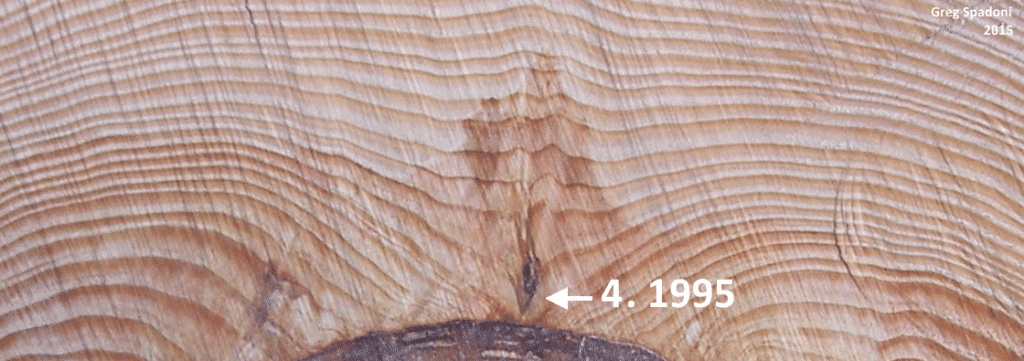
The 1976 wound was completely covered over by new wood in 1995. Photo by Greg Spadoni.
The tree was left with quite a dimple in the bark after the wound was fully covered with new wood. It was several more years before the dimple was filled in. It clearly shows in the photo that the new rings were much thicker over the dimple as the tree trunk restored its general shape.
The last growth ring was added in 2014, and the tree was cut down in the first part of January 2015.
The tree’s middle years
We’ve just seen what the fairly smoothly cut stump of this Douglas fir can tell us about its last 38 years. Now let’s see what it has to say about its life before it was wounded in 1976.
Starting at 1976 and counting backwards, there are relatively thick rings until 1957. From 1957 on back, all the way to the center of the tree, the rings are very much narrower. That shows the tree was growing beneath the very shady canopy of one or more larger trees near it. It wasn’t getting as much sunlight as it could use, so grew more slowly, adding less new wood than it otherwise would have.
The abrupt change from narrow rings to thicker rings also tells us that the taller, shading tree or trees were no longer standing as of late 1957 or early 1958.
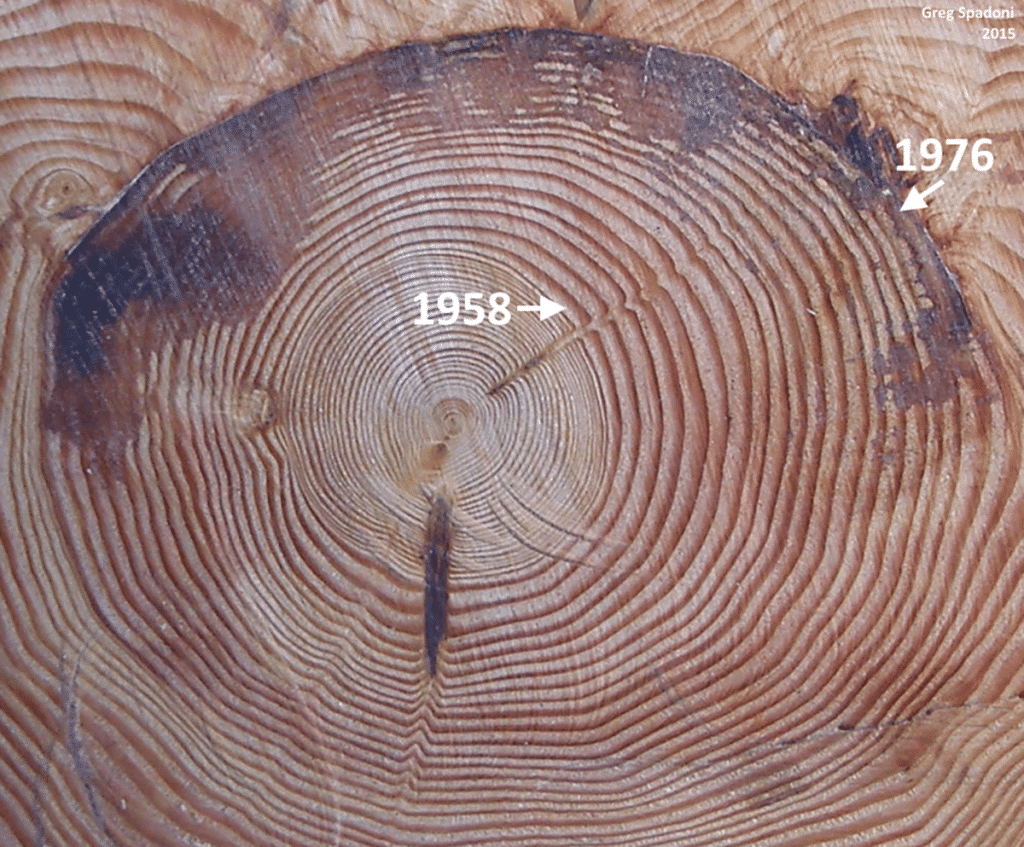
The tree’s growth rings from 1958 to 1976 are easy to see. Photo by Greg Spadoni.
Throwing shade
What happened to the tree’s shade?
The tree or trees providing the shade died. They could have died on the stump (still standing, but without any needles or leaves, which do most of the shading), could have been blown over in a windstorm, or could have been cut down. The evidence of one tree having been suddenly exposed to more sunlight doesn’t tell us which one of those three things happened to the tree or trees that were shading it. What does tell us is the evidence of many surrounding trees.
Every tree old enough to have been established before 1957 that was cut down in 1976 during the clearing of the home site and driveway where the photographed stump had grown showed the same pattern of accelerated growth beginning in the same year. That means the land was logged in late 1957 or early 1958. The logging opened the sky to all the trees that were too small to be sold for milling into lumber, so were left behind.
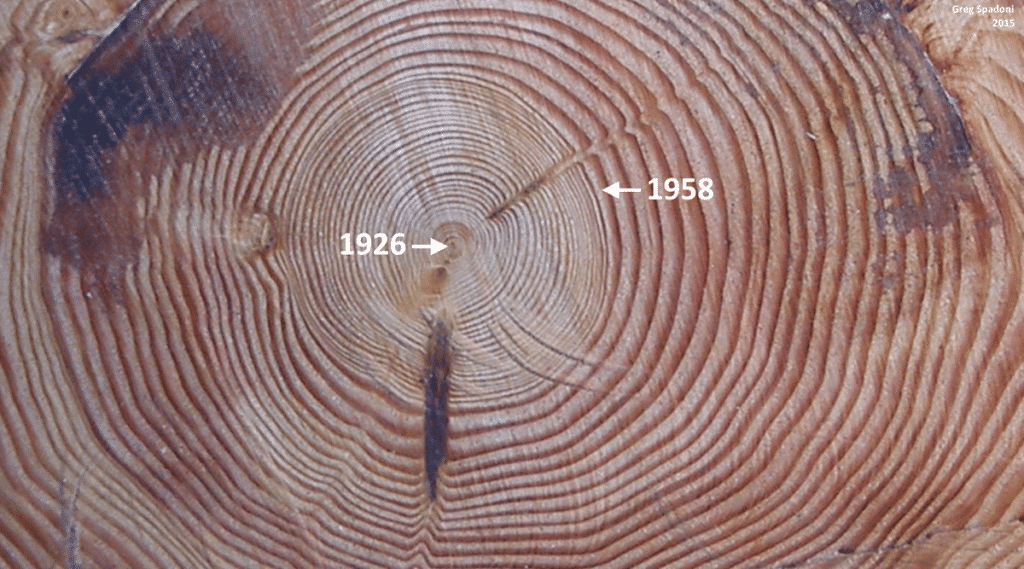
The annual rings show the tree’s slow growth during its pre-1958 life. Photo by Greg Spadoni.
Working backwards from the thicker ring of 1958, the smaller rings count back to about 1926. (Because they’re so small, it’s nearly impossible to see the last few individual rings in the photograph.) Now the tough part begins: trying to determine how many years it took the tree to reach the height at which the stump was cut. This stump was cut two feet above the ground. How long was it before this tree reached that level? Four years? Five years? Six, maybe?
Douglas fir seedlings grow slowly in deep shade. Without knowing the degree of shading, coupled with a general lack of knowledge of the various rates of Douglas fir seedling growth, I can only guess. My non-knowledgeable guess is about six years. That puts the tree’s sprout date around 1920. That’s about when the old growth was logged off the property, so it fits pretty well.
There is one last thing to point out on the stump’s cross section. The two thin lines radiating out from the center at about 2 o’clock and 6 o’clock are tiny, twig-sized limbs that lasted quite a few years before they were shaded out by the tree’s own upper limbs, and died.
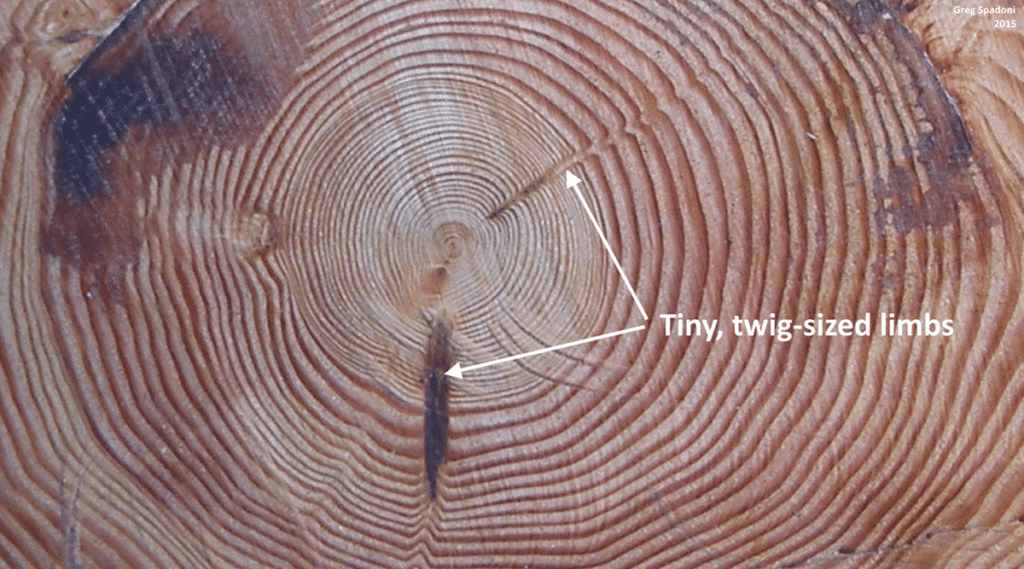
Cross sections of logs also show limbs. Photo by Greg Spadoni.
Another slice
A second cross section of the same tree, a couple feet higher than the one we’ve been looking at, shows that the 1976 wound was not the first it had suffered. The dark pitch line at the outer edge of the smaller rings shows it had been wounded during the late 1950s logging. It also completely healed over before bugs or pathogens could become established in the exposed sapwood.
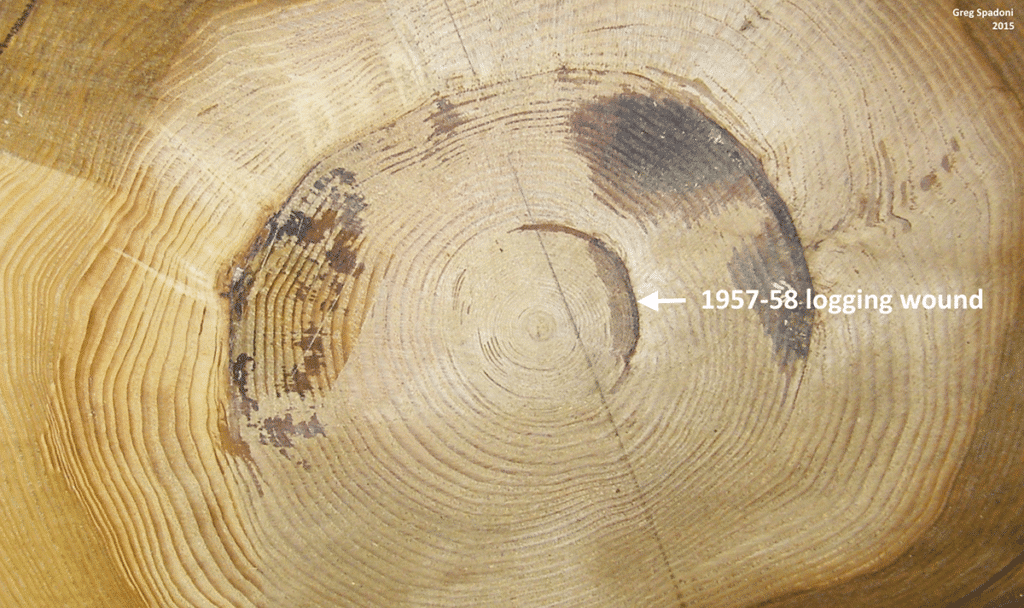
The same tree had been wounded during the logging that opened it up to enough sunlight to grow faster. Photo by Greg Spadoni.
Reviewing the stump’s life
Today’s example of two cross sections of a Douglas fir stump tells quite a bit about the tree’s life.
- It sprouted from a seed around 1920, likely soon after the old-growth forest around it had been logged.
- It struggled under the shade of taller trees around it until late 1957 or early 1958 when the second-growth next to it was cut.
- It was wounded during that logging when a chunk of bark was scraped off, but survived. It then grew at a much faster rate for the rest of its life.
- It suffered another sizeable bark wound in 1976, which it effectively sealed off, first with pitch, then, over the following 19 years, with new layers of wood.
- It took several more years before the dimple remaining in the healed wound filled in.
- The tree was cut down in early 2015.
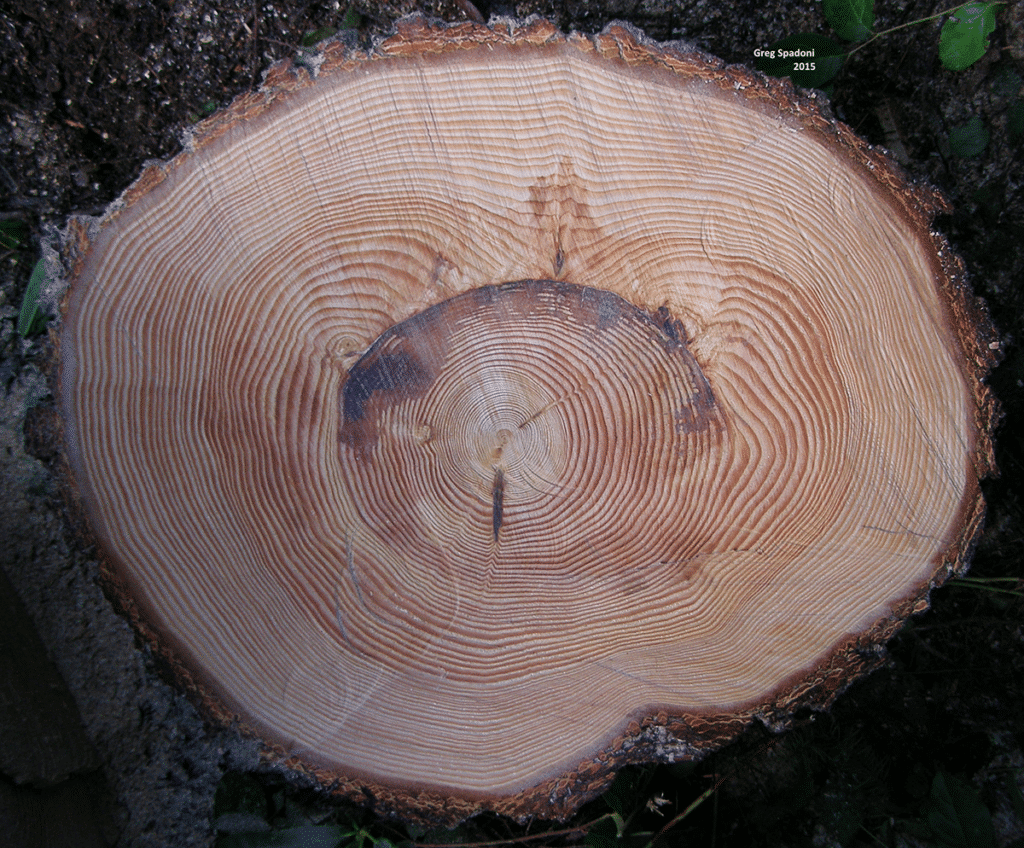
The entire slice. Photo by Greg Spadoni
Tree rings are not the only things inside of trees that tell stories of the past. We will feature some of those other, less common, things in a future column. Some of those are big surprises.
Item of Mystery
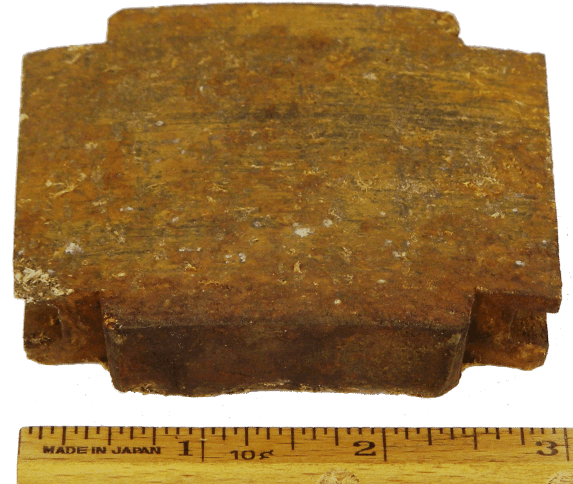
The new clue to the tired, old Item of Mystery bit is: This one has never been used.
New business
The Gig Harbor Peninsula has had telephone service since 1907. In February of that year the newly-formed Gig Harbor Improvement Club, in one of its first acts, appointed a committee to look into the possibility of finding an established telephone company in Tacoma willing to provide telephone service between there and Gig Harbor. Failing that, they were determined to build their own system.
We don’t know if it was due to the prodding of the Improvement Club, but two separate new companies were formed that year to provide it. The Bay-Island Telephone Co. was incorporated in April, 1907, soon followed by the Island Empire Telephone & Telegraph Co. in June.
The Bay-Island Telephone Co. doesn’t seem to have done anything beyond incorporate. It was the Island Empire Telephone & Telegraph Co. that built a system and provided the first telephone service on the Gig Harbor Peninsula.
Telephone service in Gig Harbor began in September 1907.
The Island Empire’s first telephone system was battery based. Every customer had a battery to power their telephone. To call another party, you first contacted the operator, and she (telephone operators were almost always women) would connect you to your party.
Our telephone-based questions for this week are:
When was telephone service between Gig Harbor and Tacoma first established?
Because the subject of the column following our next one is early automobile dealerships in Gig Harbor, here’s a combined telephone and automobile dealership question, without any other setup:
What was the telephone number for Gig Harbor’s first automobile dealership?
While we’re at it, why not throw this one in too?
What was the telephone number for Gig Harbor’s second automobile dealership?
One more telephone question
Long before cell phones were invented, there were such things as mobile phones. They weren’t something you could carry around with you, but they went everywhere your car traveled. They were called car phones or mobile phones, and judging by how few people had them, they must’ve been either very expensive or unreliable. Our fourth question of local history this week concerns car phones.
In what year did Gig Harbor’s telephone company announce that car phones would soon be available to any Gig Harbor-Key Peninsula customer?
An interesting clue is that … no, that would give too much away. (Don’t you hate that?)
We’ll have the answers to these four telecommunication questions on Feb. 10.
We will also smoothly and seamlessly segue into the new topic, which we’ve already stated will be early Gig Harbor automobile dealerships. At least that‘s the plan. Transitional chuckholes are always a possibility. Having a background in road construction, which included asphalt paving, you’d think I’d know how to handle them, but we never tried to smooth them out with text. We’ll see how it goes.
Greg Spadoni, January 27, 2025
Greg Spadoni of Olalla has had more access to local history than most life-long residents. During 25 years in road construction working for the Spadoni Brothers, his first cousins, twice removed, he traveled to every corner of the Gig Harbor and Key Peninsulas, taking note of many abandoned buildings, overgrown farms, and roads that no longer had a destination. Through his current association with the Harbor History Museum in Gig Harbor as the unofficial Chief (and only) Assistant to Linda McCowen, the Museum’s primary photo archive volunteer, he regularly studies the area’s largest collection of visual history. Combined with the print history available at the Museum and online, he has uncovered countless stories of long-forgotten local people and events.

